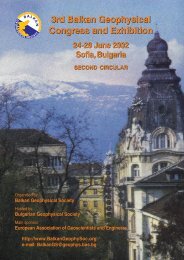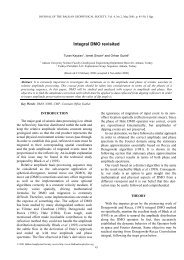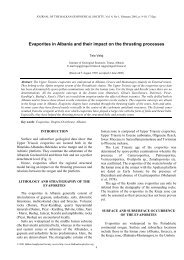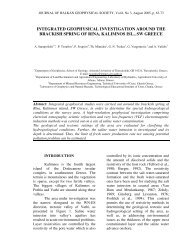Application of inverse ray-tracing seismic modelling techniques
Application of inverse ray-tracing seismic modelling techniques
Application of inverse ray-tracing seismic modelling techniques
You also want an ePaper? Increase the reach of your titles
YUMPU automatically turns print PDFs into web optimized ePapers that Google loves.
<strong>Application</strong> <strong>of</strong> <strong>inverse</strong> <strong>ray</strong>-<strong>tracing</strong> <strong>seismic</strong> <strong>modelling</strong> <strong>techniques</strong> ... 113<br />
values. The lowest values <strong>of</strong> the P-wave velocity <strong>of</strong> the<br />
first layer (800 – 900 m/s) around 80-100 m and 130-<br />
160 m are concentrated in very shallow depths and could<br />
not lead to any concern about the compactness <strong>of</strong> this<br />
layer. These low values can be attributed to a natural<br />
deterioration <strong>of</strong> the superficial materials.<br />
The <strong>ray</strong>-coverage <strong>of</strong> IKRP1 was dense enough to<br />
describe the P-wave velocity <strong>of</strong> the first layer and the<br />
upper part <strong>of</strong> the bedrock (See Figure 4 – upper panel).<br />
This was succeeded by utilizing 48 geophones and 7<br />
shots which are the maximum limits <strong>of</strong> the processing<br />
capabilities <strong>of</strong> the SIPT algorithm. The fitting between<br />
calculated and observed times was very good (Figure 4<br />
– lower panel) since the RMS error was not higher than<br />
1.2 ms.<br />
We also tested the stability <strong>of</strong> the final model (Fig.<br />
5a) by perturbing it at one point (180 m). Actually, we<br />
moved the boundary node <strong>of</strong> this point upwards for 2 m.<br />
The velocity model then was modified (Fig. 5b). A new<br />
data set was created by forward <strong>modelling</strong>. This data<br />
was inverted by using the final model as a starting model.<br />
The inversion produces a new model (Fig. 5c). The<br />
purpose was to check if the final model was sensitive<br />
to small perturbations. We found out that the model<br />
was stable, since the smearing around the anomaly was<br />
very small. The resulted model after the inversion <strong>of</strong><br />
the perturbed data is shown in Figure 5c. Figure 5d<br />
shows the initial perturbation <strong>of</strong> the model (difference<br />
between 5a and 5b), the Figure 5e shows the resulted<br />
anomaly (difference between 5a and 5c) and the Figure<br />
5f shows the difference between the two anomalies (5d<br />
and 5e). We can notice that the difference is very small<br />
and we can conclude that the inversion is stable.<br />
We also estimated the elastic modulus <strong>of</strong> the materials<br />
in the IKRP1 section. The resulted section is shown<br />
in Figure 6.<br />
The comparison <strong>of</strong> the new results with the previous<br />
ones showed a very good agreement in the depth estimation<br />
<strong>of</strong> the bedrock. Figure 7 shows the refraction<br />
pr<strong>of</strong>ile as resulted from the SIPT1 processing. The<br />
velocity distribution <strong>of</strong> the first layer is presented in<br />
Figure 8. The estimated velocity values by SIPT1 (see<br />
Fig. 8) agreed well with the values <strong>of</strong> the first six meters<br />
material in the Rayinvr model. This was expected since<br />
the major part <strong>of</strong> the first layer <strong>ray</strong>s came through these<br />
first meters. If Karmis et al., (1997) had not conducted<br />
supplementary geophysical methods such as geoelectrical<br />
pr<strong>of</strong>iling or electromagnetic soundings, they could<br />
not be able to evaluate the quality <strong>of</strong> the interpretation<br />
for the layers deeper than 5-6 m. The modern <strong>modelling</strong><br />
technique able to handle models with linear velocity<br />
increase allowed estimating velocity at those depths.<br />
The deteriorated area at the eastern part <strong>of</strong> the<br />
investigated area was detected by both the IKRP2 and<br />
IKRP3 lines. We present P-wave velocity and elasticity<br />
modulus sections obtained from the <strong>modelling</strong> <strong>of</strong> line<br />
IKRP2 pr<strong>of</strong>ile (Fig. 9). It is easily seen that the area over<br />
120 m has lower values <strong>of</strong> P-wave velocity. Figure 10<br />
shows the velocity graph <strong>of</strong> the previous processing.<br />
Although the velocity variation is clear in this section,<br />
it is difficult to decide if the low velocity zone is limited<br />
inside the upper layer without additional information.<br />
Seismic line IKRP4 (Figure 11) also indicates a<br />
small deterioration in the upper part <strong>of</strong> the first layer.<br />
The estimated velocities by the previous processing are<br />
presented by red lettering. The agreement between the<br />
two processing methods as far as the P-wave velocity<br />
is concerned, was very good. However the new processing<br />
succeeded to specify better the area with the lower<br />
velocities.<br />
CONCLUSIONS<br />
The reprocessing <strong>of</strong> the data leads to obtain new<br />
information about the velocity field derived from the<br />
<strong>seismic</strong> refraction survey. It also provides an idea about<br />
the quality <strong>of</strong> the previous <strong>inverse</strong> <strong>modelling</strong> results.<br />
The former <strong>techniques</strong> could not estimate the velocity<br />
values in the deeper part <strong>of</strong> the upper layer since they<br />
could not handle models with a gradient increase in the<br />
velocity field.<br />
The reprocessing <strong>of</strong> the data is worth trying since<br />
new information can be derived from the former <strong>seismic</strong><br />
refraction experiments having extensive <strong>ray</strong>-coverage.<br />
In Greece, there are many datasets i.e. important engineering<br />
<strong>seismic</strong> surveys and crustal investigations. This<br />
work shows that the reinterpretation <strong>of</strong> these datasets<br />
would be very useful.<br />
REFERENCES<br />
Clowes, R. M., Zelt, C. A., Amor, J. R. and Ellis, R. M., 1995.<br />
Lithospheric structure in the southern Canadian Cordillera from a<br />
network <strong>of</strong> <strong>seismic</strong> refraction lines: Can. J. Earth Sci., 32, 1485–<br />
1513.<br />
Haeni, F. P., 1986. <strong>Application</strong> <strong>of</strong> <strong>seismic</strong>-refraction <strong>techniques</strong> to<br />
hydrologic studies: U.S. Geological Survey Open File Report<br />
84-746, 144.<br />
Haeni, F. P., Grantham D. G., and Ellefsen K., 1987. Micro-computer-based<br />
version <strong>of</strong> SIPT-. A program for interpretation <strong>of</strong><br />
<strong>seismic</strong> refraction data: U.S. Geological Survey Open file report<br />
87-103-A. Hartford, Connecticut.<br />
Hagedoorn J. G., 1959. The plus-minus method <strong>of</strong> interpreting<br />
<strong>seismic</strong> refraction sections: Geophysical Prospecting, 7, 158-182.<br />
Huang, H., Spencer, C. and Green, A., 1986. A method for the<br />
inversion <strong>of</strong> refraction and reflection travel times for laterally<br />
varying velocity structures: Bull. Seism. Soc. Am., 76 , 837-846.<br />
Karastathis, V. K., Papamarinopoulos S. and Jones R. E., 2001.<br />
2-D velocity structure <strong>of</strong> the buried ancient canal <strong>of</strong> Xerxes:<br />
An application <strong>of</strong> <strong>seismic</strong> methods in archaeology: Journal <strong>of</strong><br />
Applied Geophysics, 47, 29–43<br />
Karmis P., Louis J. F. and Karastathis V. K., 1997. Site characterisation<br />
by geophysical methods - A case history: Proceedings,<br />
International Symposium on Engineering Geology and the Environment<br />
- Greek National Group <strong>of</strong> International Association<br />
<strong>of</strong> Engineering Geology (IAEG), Athens, 1997, 1285 - 1291.








